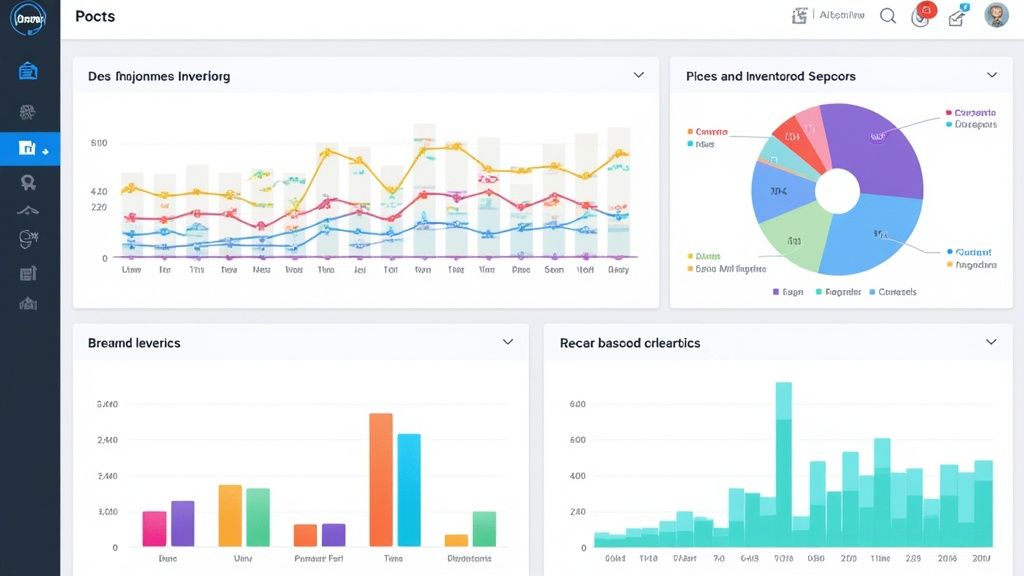The Evolution of Inventory Management: A Journey Through Innovation

Good inventory management makes or breaks any product-based business. Getting it right means having the right items on hand when you need them – no more, no less. The story of how we got to today’s sophisticated systems is fascinating and gives us valuable context for current best practices. The shift from paper records to smart software shows just how far we’ve come in making inventory tracking more accurate and efficient. Want to dive deeper into the history? Check out this detailed overview.
From Manual to Mechanical: The Early Days of Inventory Control
At first, tracking inventory was purely hands-on work. Shop owners counted items manually and wrote everything down in paper ledgers. While straightforward, this method was slow and mistakes were common. The clear need for better solutions pushed businesses to look for new ways to manage their stock.
The Rise of Computers and Software
When computers arrived in the 1950s and 60s, they changed inventory management completely. Digital systems brought speed and accuracy that paper records could never match. Businesses could now handle much larger inventories with fewer errors. This laid the groundwork for the specialized inventory software we use today.
The Impact of Barcodes and RFID
Barcodes and RFID tags brought another big leap forward. Barcodes made it quick and simple to identify products, while RFID enabled tracking items without even seeing them. These tools made warehouse operations much smoother and more precise. Now, most major businesses rely on these technologies to run their operations.
Modern Inventory Management: The Age of Data
Today’s inventory systems run on data. Smart analytics and AI look at past sales patterns to predict future needs and keep stock at optimal levels. This helps companies cut storage costs and avoid running out of products. Numbers and insights now drive inventory decisions more than ever before.
The Future of Inventory Management
The next chapter of inventory management looks promising with new tech on the horizon. IoT devices could soon give real-time updates on stock levels throughout the supply chain. Combined with AI systems and blockchain records, these tools will make inventory tracking even more seamless. The field keeps evolving to meet new challenges and opportunities.
Mastering Inventory Accuracy: Your Path to Operational Excellence

Knowing exactly what’s in your warehouse is essential for any business. Current data shows that US retail inventory accuracy hovers around just 63%, meaning over a third of inventory records contain errors. These mistakes lead directly to stockouts and excess inventory that eat into profits. Getting inventory right cuts waste and reduces storage costs substantially. See the latest industry statistics.
Better Results Through Cycle Counting
Regular cycle counts offer a practical way to stay on top of inventory without disrupting operations. Instead of shutting down for a full annual count, this approach lets you check small sections continuously while keeping business moving.
- Set Up Your Schedule: Plan counts based on item value and how often products move. Count your most important items more frequently.
- Staff Training: Make sure your team knows proper counting methods and how to use scanning equipment correctly. Good training leads to reliable results.
- Check Every Error: When counts don’t match records, find out why immediately. Quick investigation prevents small issues from becoming bigger problems.
Using Smart Tools for Better Accuracy
Basic tools like barcode scanners and RFID tags make a big difference in inventory tracking. These devices eliminate typing errors and speed up counting significantly. Barcode scanners capture product details instantly, while RFID tags monitor item locations automatically throughout your facility.
Creating Team Accountability
Good inventory management requires everyone to do their part. When staff members take ownership of accuracy, the whole system works better. Here’s what helps:
- Clear Job Roles: Make sure everyone knows their specific inventory responsibilities
- Regular Checks: Schedule routine audits to verify records match physical counts
- Track Progress: Monitor key accuracy metrics and share results with staff. Recognize good work to encourage continued care.
Managing Data Quality at Scale
As inventory grows, keeping accurate records becomes more challenging. Good data checking systems help catch problems early. Your software should flag unusual patterns that might signal counting errors. Quick corrections prevent small mistakes from causing bigger issues later. This careful attention to detail helps maintain accuracy even with large inventories.
Economic Order Quantity: Smart Decision-Making for Optimal Stock Levels
Keeping the right amount of inventory is like walking a tightrope – you need enough stock to meet customer needs while keeping storage costs low. The Economic Order Quantity (EOQ) model helps solve this puzzle by finding the ideal order size that minimizes overall costs. The concept is straightforward: ordering huge batches saves on order costs but increases storage expenses, while frequent small orders mean lower storage needs but higher ordering fees.
EOQ provides a practical way to find that balance point by looking at key factors like yearly demand, cost per order, and storage costs per unit. This lets businesses calculate the optimal order size to keep total costs down. One important note: EOQ works best with steady demand patterns. You can find detailed data and research on EOQ effectiveness in this study.
Making EOQ Work in the Real World
While EOQ math may look perfect on paper, real business situations need a more flexible approach. Customer demand rarely stays perfectly steady – it shifts with seasons, market changes, and unexpected events.
Take a clothing store as an example. They might increase their EOQ for winter coats in fall to prepare for cold weather shopping, rather than placing lots of small orders during peak season. In summer, they’d likely lower the EOQ for those same coats since demand drops off.
Using EOQ with Other Stock Management Tools
EOQ works best when paired with other proven inventory methods. Two great companion approaches are Just-in-Time (JIT) inventory and ABC analysis.
JIT focuses on getting products right when needed, which works especially well for businesses with predictable demand and reliable suppliers. This keeps storage costs low and reduces the risk of items becoming outdated.
ABC analysis groups inventory by value and use. “A” items are your most valuable and frequently used stock that needs close tracking. “B” items fall in the middle, while “C” items need less strict oversight. Using ABC with EOQ helps focus your inventory efforts where they matter most – like using EOQ primarily for those critical “A” items.
Real-World Limits and Practical Tips
While EOQ offers solid guidance, it’s important to know its limits. The steady demand assumption doesn’t match reality for many businesses. The basic EOQ formula also misses potential bulk order discounts from suppliers.
Figuring out true storage costs takes careful math – you need to count space costs, insurance, the risk of items becoming outdated, and money tied up in inventory. Despite these challenges, EOQ remains helpful for many companies. It gives a good starting point for order planning and cost control. When combined with other methods and adjusted for real conditions, EOQ can help improve your bottom line. eStore Factory specializes in helping Amazon sellers put these inventory tools to work effectively. Reach out to learn how we can help optimize your inventory approach.
Using Data Analytics To Improve Your Inventory Management

Smart inventory management relies on data, not guesswork. When businesses analyze their numbers properly, they can make better choices about stock levels and ordering. This leads to more efficient operations and better profits.
Using Predictions to Plan Ahead
Historical data helps predict what customers will want in the future. A good example is how retail stores look at past holiday sales to plan their upcoming seasonal inventory. This helps them stock the right amount of popular items while avoiding excess inventory of slower-moving products.
How AI Makes Inventory Smarter
Artificial intelligence and machine learning can process huge amounts of data to spot patterns humans might miss. The software can automatically adjust inventory levels based on these insights. For businesses dealing with complex supply chains, this automated approach saves time and reduces errors compared to manual methods.
Quick Response with Live Data
Having access to real-time inventory data means businesses can act fast when things change. For example, if a product suddenly becomes popular on social media, companies can quickly order more stock to meet the surge in demand. This kind of quick response helps businesses stay competitive.
Inventory Source offers tools that help businesses analyze sales history and spot trends that affect inventory needs. This helps prevent running out of stock while keeping customers happy.
Getting Started with Data
You don’t need fancy systems to begin using data. Even basic spreadsheets can provide useful insights into sales patterns and trends. As your business grows, you can move to more advanced tools that offer deeper analysis and automation.
Real Success Stories
Many retailers are already using data to improve their inventory game. Some track local buying habits to stock different products at different stores. Others use AI to automatically reorder products when stock gets low. These approaches help cut waste and boost profits.
The key takeaway: Data-driven inventory management helps businesses order smarter, reduce costs, and keep customers happy. When done right, this leads to better financial results and a stronger market position.
Just-in-Time and Lean Inventory: Building Efficient Operations

Just-in-Time (JIT) and Lean inventory help businesses run more efficiently by keeping just enough stock on hand. These methods focus on having inventory exactly when it’s needed – no more, no less. The result? Lower costs and faster response to market changes.
Understanding the Core Principles of JIT
Think of JIT like a well-timed dance – materials arrive right when production needs them. A car factory using JIT might get tire deliveries just hours before they’re installed on vehicles. This requires excellent supplier coordination and precise timing.
The Benefits and Challenges of JIT Implementation
The biggest win with JIT? Major savings on storage costs. You spend less on warehousing, and insurance, and avoid losses from outdated stock. Products also tend to be higher quality since materials spend less time sitting around where they could get damaged.
But JIT isn’t without risks. One delayed shipment can halt your entire operation. That’s why strong supplier relationships and backup plans are essential.
Lean Inventory: Minimizing Waste Throughout the Process
Lean takes a wider view than JIT. It looks at cutting waste from start to finish – fewer defects, faster production times, and smoother workflows. Small improvements add up to big gains over time.
Implementing Lean Principles for Effective Inventory Control
Value Stream Mapping helps track a product’s journey from raw materials to finished goods. This visual tool spots bottlenecks and waste. The 5S system – Sort, Set in order, Shine, Standardize, Sustain – keeps workspaces organized and efficient.
Combining JIT and Lean for Optimal Results
JIT and Lean work better together. JIT handles timing while Lean tackles overall efficiency. A furniture maker might use Lean to organize their shop floor better, then add JIT to get materials right when needed. Together, they create a complete system for smooth operations.
Adapting JIT and Lean to Different Business Needs
These methods work beyond manufacturing. A bakery could use JIT for fresh ingredients, while a hospital might apply Lean to reduce patient wait times. Online sellers can benefit too – eStore Factory helps Amazon sellers find the right mix of these techniques. Reach out to learn how we can improve your inventory strategy.
The Future of Inventory Management: Emerging Technologies and Trends
Managing inventory effectively has become more important than ever for businesses. New tools and systems are making it easier to track stock levels, reduce costs, and meet customer demand. Let’s look at the key technologies shaping inventory management’s future.
The Internet of Things (IoT): Real-Time Visibility
The Internet of Things (IoT) is changing how businesses monitor their inventory. Smart sensors can now track product location, temperature, and condition in real-time. This gives companies instant insights to prevent stockouts and reduce waste. For instance, grocery stores use IoT sensors to monitor food freshness and get alerts if temperatures exceed safe levels.
Blockchain: Enhanced Transparency and Security
Blockchain technology creates an unbreakable record of every product’s journey. This helps businesses:
- Prevent fake products from entering the supply chain
- Track where items came from and went
- Build trust with customers through transparency
- Share accurate supply chain data with partners
Artificial Intelligence (AI) and Machine Learning (ML): Predictive Power
AI and ML systems take the guesswork out of inventory planning. These tools analyze past sales, trends, and other data to accurately predict future demand. Online retailers use AI to prepare for seasonal spikes, ensuring they stock enough products when customers need them most.
Robotics and Automation: Streamlining Warehouse Operations
Modern warehouses increasingly rely on robots for basic tasks like:
- Picking products from shelves
- Packing orders
- Sorting items efficiently
- Moving stock between locations
While robots require significant upfront investment, they boost productivity and reduce long-term labor costs. Many businesses find the efficiency gains worth the initial expense.
Preparing for the Future of Inventory Management
To successfully adopt new inventory technologies:
- Review your current processes to identify improvement areas
- Choose tools that match your specific business needs
- Train employees on new systems
- Build the right technical foundation
- Start small and scale up gradually
Are you selling on Amazon and want to improve your inventory management? eStore Factory can help optimize your systems and strategy for better results.

